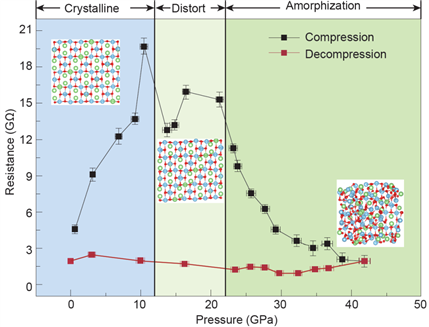Pressure makes better Li-ion battery- Dr. Lin Wang
NOVEMBER 9, 2018
New work from a team of scientists led by Dr. Lin Wang of HPSATR found that high pressure turned so called zero-strain anode Li-ion battery (Li4Ti5O12 or LTO) to amorphous and made its electrical conductivity largely improved. This study offers a new method for improving the conductivity of lithium-ion batteries using high-pressure technique. The work is published in recent National Science Review.
Lithium-ion batteries have been widely used in portable electronic devices, especially in mobile applications such as personal electronics and electric cars.
lithium titanate (LTO) is a promising lithium battery due to its low toxicity, low raw material cost and long cycle life, which make LTO a promising anode for Li-ion batteries. However, the main problem of LTO is its poor electric conductivity, which limits its practical application. Therefore, the improvement of its conductivity is a long-standing challenge.
“To increase the conductivity of LTO, we need to improve the migration ability and open level of the immigration channels of Li ion, while the two factors compete sometimes”, said Dr. Yanwei Huang, the lead author. “Pressure has been found as a powerful tool to modulate physical properties of energetic materials. We expect that pressure may provide some help for making a compromise of the two ends”, added Dr. Lin Wang, a staff scientist of HPSTAR.
The research team carried out in situ high pressure X-ray diffraction and Raman experiments on LTO combined with theoretical calculations. They studied how pressure affects the structural and electrical properties of LTO up to nearly 500 thousands times normal atmospheric pressure.

They found that the spinel LTO is not that stable under compression, which turned to amorphous around 270 thousands times normal atmospheric pressure. What excited the scientists is that the electrical conductivity of the decompressed amorphous LTO was improved by an order compared with the original crystallized LTO.
“This means that pressure can be used to improve the long-existied poor conductivity of LTO lithium battery”, said Dr. Lin Wang.
To better understand the pressure induced amorphization and enhanced conductivity, they carried out further calculations. They found that the difference in the compressibility of the crystal structure is the key for the pressure induced amorphization. Why the amorphous LTO shows much higher conductivity? That’s because the amorphous promotes the Li ion diffusion and thus enhance its ionic conductivity by providing ion migration defects.
“Our study shows that pressure can be used to improve the materials’ ionic conductivity”, remarked Dr. Yu He, the co-led author. “We may use high-pressure to find other lithium batteries with better electrical conductivity”.
Caption: The resistance of LTO changes with increasing and decreasing pressure, the inset figures show the corresponding structures at different pressure regions. It indicates that LTO undergoes crystalline-distortion-amorphous transitions under high pressure. The resistance increases at lower pressures during the lattice distortion, then it starts to decrease sharply as amorphization takes place at higher pressure. The amorphous LTO can be decompressed down to ambient pressure and has much better conductivity compares with the crystalline LTO.
压力作为重要的热力学参数,可以改变物质的原子间距,并引发一系列材料结构与性质的变化,很多常温常压下稳定的材料,在高压下都会发生压致相变产生一种或多种新型化合物,可见压力为新材料的探索提供了一个新的维度,因此高压下探索和合成新型材料已经成为一个重要的研究方向。但对于锂离子电池材料,压力通常会限制锂离子在晶格中的迁移和扩散,从而导致较低锂离子电导率,阻碍了高压下获得的新材料在锂离子电池中的应用。最近,北京高压科学研究中心王霖课题组和中国科学院地球化学研究所李和平课题组合作,结合高压实验研究方法和第一性原理计算的方法,对Li4Ti5O12(LTO)在高压下的压致非晶相变和电导率的性质和机理进行了系统性研究。以“零应变”著称的新型锂离子电池负极材料钛酸锂(Li4Ti5O12—LTO)与锂离子电池中广泛使用的碳负极材料相比,具有非常优越的循环性能和使用寿命。北京高压科学研究中心的王霖研究员带领的研究团队通过高压的方法使得钛酸锂电池的电导率得到了极大的提高。相关结果发表于近期的《国家科学评论》。
